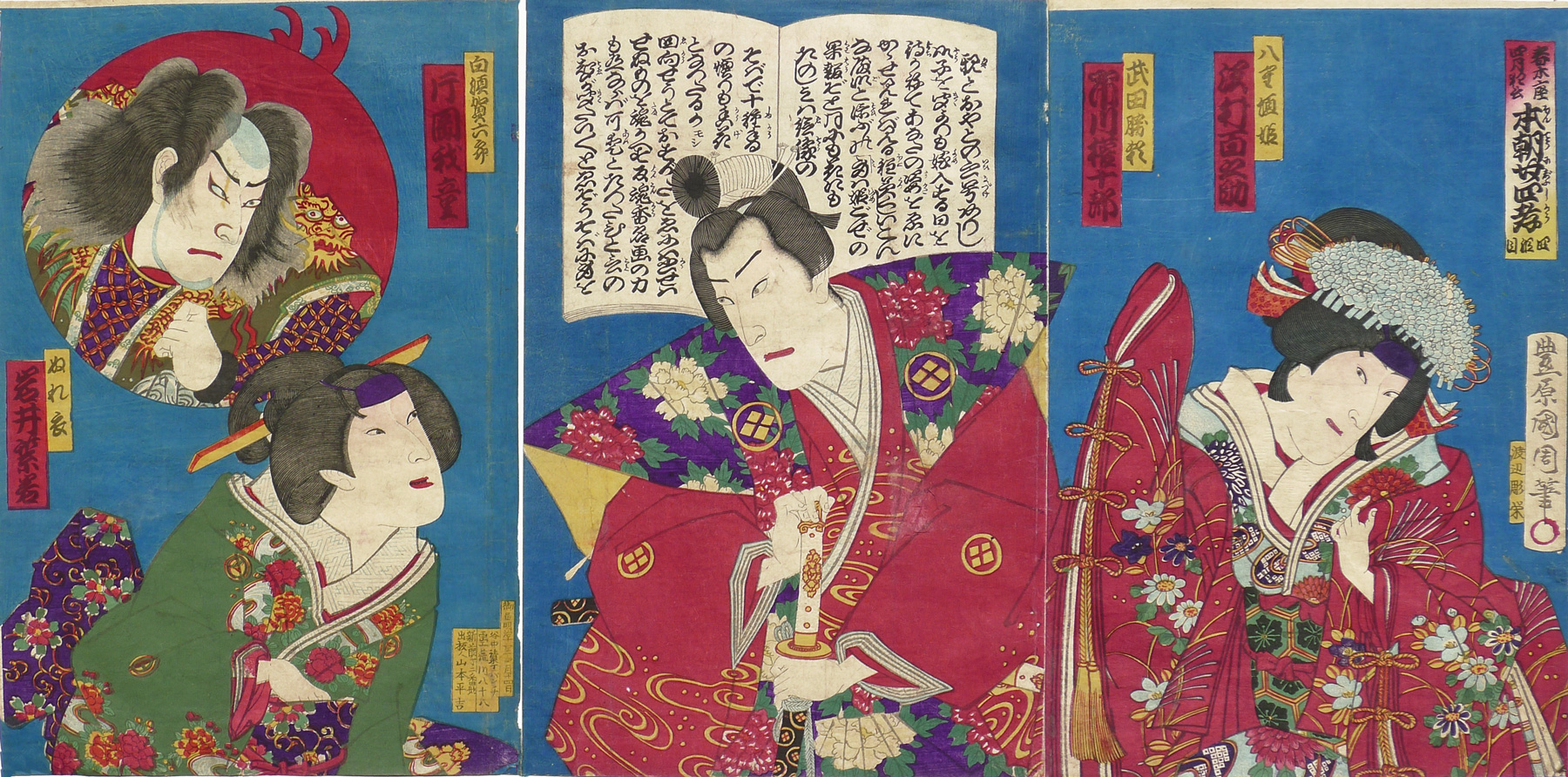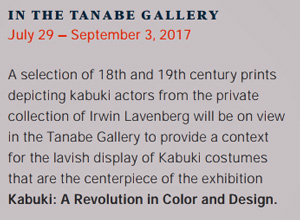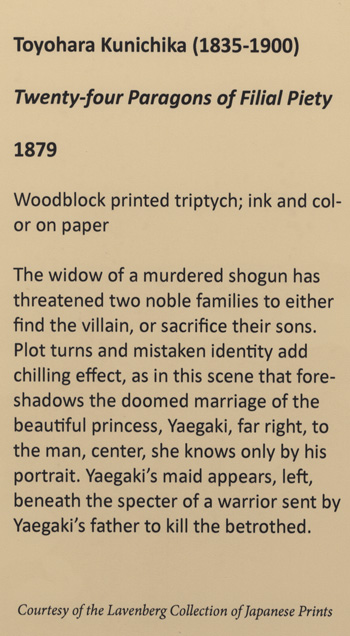About This Print
Picturing from right to left the actors Sawamura Hyakunosuke 沢村 百之助 as Yaegaki hime 八重垣姫 (Princess Yaegaki, Nagao Kenshin's beautiful daughter); Ichikawa Gonjūrō 市川権十郎 as Takeda Katsuyori 武田勝頼 (in love with Yaegaki); Iwai Shijaku IV 岩井紫若 as Nureginu ぬれぎ (Yaegaki’s maid) and Kataoka Gadō 片岡 我童 as Shirasuga Rokurō 白須 賀 六郎 (a retainer of Yaekagi’s father sent to kill Katsuyori) in the Jusshukō scene in the play Honchō Nijūshikō 本朝廿四孝 (Twenty-four Paragons of Filial Piety.)
introduction of brilliant colors derived from synthetic dyes that smacked of evolving times. Even so, traditions in kabuki print design remained: details masterfully rendered; cartouches giving the actor's name and role; the action unfolding across multiple sheets of paper.
The Actors Pictured
For background on the actors pictured see their respective entries in the article The Kabuki Actor on this site.The Plot of the Play
Source: Kabuki Encyclopedia, An English-Language Adaption of Kabuki Jiten, Samuel L. Leiter, Greenwood Press, 1979. p. 123-124 and The Kabuki Handbook, Aubrey S. & Giovanna M. Halford, Charles E. Tuttle Company, 12th printing 1981, p. 66-76.
Written in the mid 1700s for the puppet theater by Chikamatsu Hanji (1725-1783), assisted by Miyoshi Shoraku (1696-1775?) and Takeda Inaba, it was later adapted for the kabuki stage.
The very intricate plot revolves around the mid-16th century feud between the Takeda and Uesugi (called Nagao in the play) clans. The Shogun Ashikaga Yoshiteru has recently been murdered, and the heads of these two noble families have been ordered by the shogun's widow to find the murderer or forfeit the heads of their heirs, Takeda Katsuyori and Nagao Kagekatsu.
Princess Yaegaki, daughter of Uesugi (Nagao), is betrothed to Katsuyori but only knows him through a portrait. Before they can get married, Katsuyori supposedly commits suicide. The real suicide victim, however, is the husband of Yaegaki's maid Nureginu.
In the most performed scene, Jūshukō (Ten Types of Incense) Yaegaki Hime and her maid Nureginu are grieving over the death of their lovers when the gardener Minosaku (Takeda Katsuyori in disguise) appears. Yaegaki falls in love with the disguised Katsuyori (her former betrothed) and asks Nureginu to be her go-between. Katsuyori asks Yaegaki for the sacred helmet originally belonging to Takeda Shingen as a token of her love. This request reveals to Yaegaki that Minosaku is none other than Takeda Katsuyori. Katsuyori continues saying he is Minosaku and Yaegaki takes Katsuyori's sword and tries to kill herself, saying she is too ashamed of what she did to get the love of somebody who is not her betrothed. Moved by Yaegaki's faithful love, Katsuyori tells her the truth.Nagao Kenshin appears on stage and sends Minosaku away to deliver a letter, He then orders his strongest retainers, the sword-bearer Shirasuga Rokurō and the spear-holder Hara Kobunji, to kill Katsuyori. This shocks the two women who try to plead Katsuyori's cause to a relentless Kenshin. Yaegaki, Nureginu and Kenshin pose as the curtain is drawn to end the scene.
Print Details
| IHL Catalog | #664 |
| Title (Description) | Sawamura Hyakunosuki, Ichikawa Gonjūrō, Iwai Shijaku IV and Kataoka Gadō in Honchō nijūshikō 本朝廿四孝 Twenty-four Paragons of Filial Piety. Also translated as Twenty-four Dutiful Sons and Twenty-four Examples of Filial Piety. |
| Artist | Toyohara Kunichika (1835–1900) |
| Signature | Toyohara Kunichika hitsu |
| Seal | Toshidama seal |
| Publication Date |  |
| Publisher |  Yamamoto Heikichi 山夲平吉 Yamamoto Heikichi 山夲平吉Left cartouche - 出板人 Shuppanjin (publisher) 山夲平吉 Yamamoto Heikichi followed by address [Marks: Publisher ref. 595] Right cartouche - 画工 gakō (artist) 荒川八十八 (Arakawa Yasohachi, the artist's given name) followed by his address |
| Carver |  |
| Impression | excellent |
| Colors | excellent |
| Condition | good - light backing; right and center sheets joined; light soiling; several repairs verso; minor trimming |
| Genre | ukiyo-e; yakusha-e |
| Miscellaneous | |
| Format | vertical oban triptych |
| H x W Paper | 14 x 9 3/8 in. (35.6 x 23.8 cm) each sheet |
| Literature | |
| Collections This Print |




